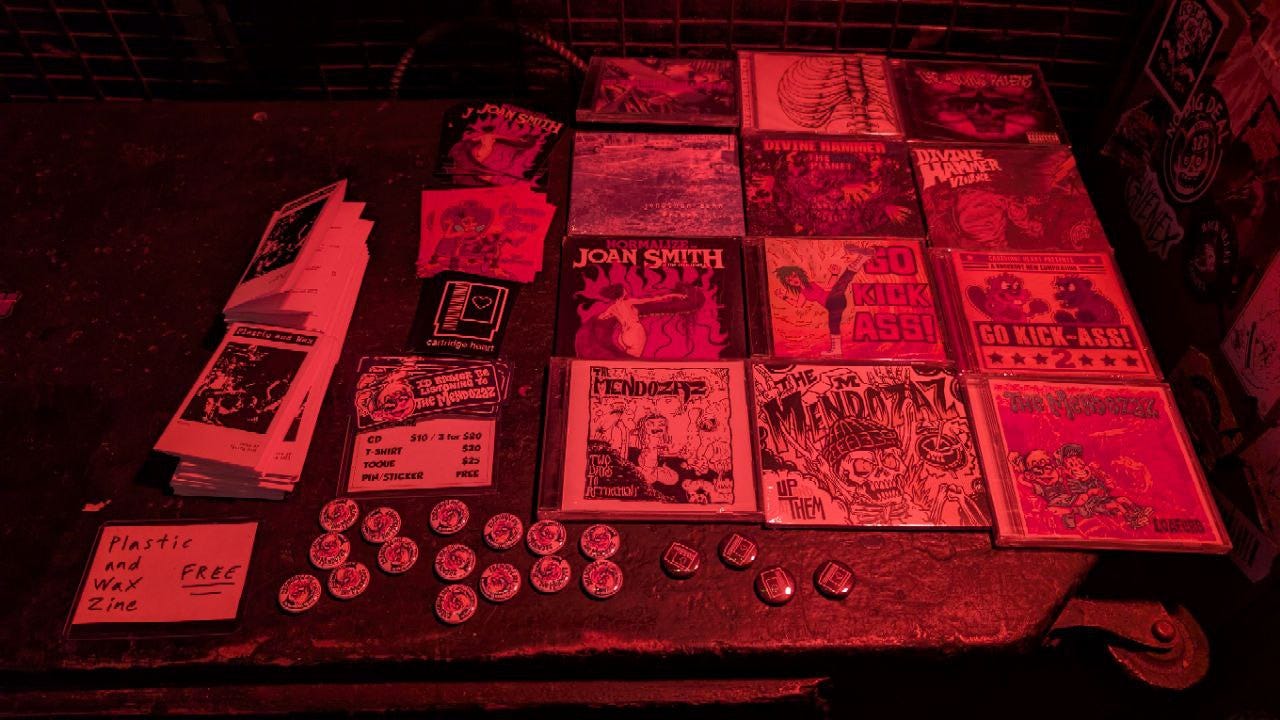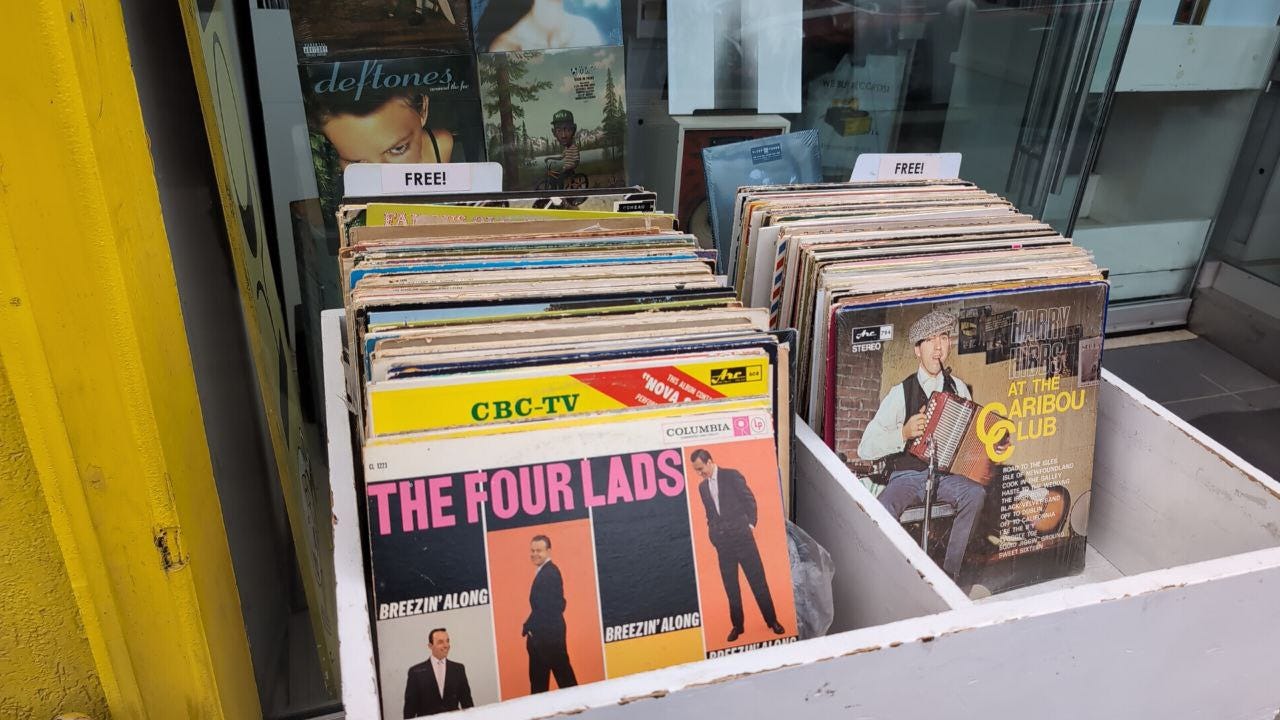Take One Free
On pins, stickers, and the semiotics of punk generosity.
The other week I found myself at the Bovine Sex Club in Toronto. That sentence should be enough, but of course it never is. I wasn’t there for anthropological reasons, though anthropology, like a bad tattoo, never really fades. I wasn’t there for the band either—The Mendozaz, though they were good, loud in the right ways, slouched in the right ways—but really, I was there for the beer, and because someone took me, and because there was no cover. That last part felt like the most honest reason anyone goes anywhere anymore.
Somewhere between the second pint and the third punk song, I found myself drifting toward the merch table. You know the layout: T-shirts folded like sacred offerings, CDs (yes, still), maybe a cassette or two for the aesthetic purists. But then—at the bottom of everything, almost like an afterthought, or maybe as close to the people as possible—a scattering of pins and stickers, resolutely free. It was made explicit in the short price list: FREE. No catch. No QR code. No sign-up sheet. Just: here you go.
Which brings us to the question I’d love to pretend just came up: why do free pins and stickers still exist?
At first glance, it's marketing, obviously. Low-cost brand spread. Punk rock SEO. You take a sticker, slap it on your water bottle, and bam, you're an unpaid ambassador. But that explanation is too clean, too capitalist, too SXSW panel. In truth, these items exist in a stranger economy—an economy of ambient affiliation, semiotic gifting, and low-stakes participation. They’re not exactly souvenirs, not quite propaganda. They’re declarations of weak ties, signaling devices that whisper instead of shout: “I was there. Sort of. At least I touched the table.”
The logic of the free sticker resembles the logic of the zine, the patch, the burned mix CD. It’s the opposite of scarcity. It’s abundance disguised as ephemera. It says: “We made too many, but we made them for you.” And in a world hyper-optimized for monetization, this surplus feels radical. Not because it rejects capitalism entirely—most bands would prefer you buy the shirt—but because it operates adjacent to it, like a side quest that turns out to be the real story.
Stickers are like tiny rites of passage. You bend down, pick one up, maybe pretend you're choosing carefully, but really you're just performing the act of receiving. And in receiving, you’re being invited—into what, exactly, is vague, which is part of the point. Punk was always allergic to clarity. The gift is small enough to be forgettable, but sticky enough to stay. Sometimes literally.
If gift economies, as Marcel Mauss taught us, are about obligations—giving, receiving, reciprocating—then the punk sticker short-circuits the third part. It demands nothing in return. There’s no follow-up, no audit trail. This isn't Burning Man with its performance of non-commerce; it's something humbler, more durable. You don’t have to build a temple and burn it down. You just have to put a little square of vinyl on your laptop and move on with your life.
In that low-level gesture, something lingers. Something circulates. Not a currency, but a texture. A reminder that not everything has to be optimized, tracked, or sold. Some things can just... be. Especially if they're printed on glossy backing and say things like “I ❤ NOISE.”
The sticker is a message, yes—but it's also a method. A way of organizing meaning without organizing people. A tactic more than a strategy. It rides on the fantasy that someone, somewhere, will see it. Maybe even care. Or maybe not. Which is fine too.
And that’s the thing about free pins and stickers: they’re not promises. They’re not contracts. They’re ambient acts of affiliation. Light touches in a heavy world. They’re not trying to convince you of anything, really. They’re just there. Like noise in the background. Or like The Mendozaz, still playing as I walked out into the Toronto night, sticker in hand, a little buzzed, and strangely, briefly, free.
For once, I don’t need to explain where or when I took the photo—it’s all in the text. I didn’t use flash. Everything turned red. It won’t win a photojournalism award. But it did its job, didn’t it? As anthropologist Ryan Anderson once wrote, you never really know when a piece of research begins (or, in this case, when any old text begins), so you might as well document everything you can. And if you can do it with photographs, even better: “This is yet another reminder for why taking good fieldnotes is so important, because you just never know where some seemingly minor detail will lead you. But in this case, don't just take notes! As I said in the opening lines of this post: take photographs as well. It doesn't matter if you're using an iPhone or an 8x10 film camera.”
The next day—broad daylight, out in the street—I was already thinking about free pins and stickers. And once you start thinking about free things, you see them everywhere. I took the photo below in a record store. More free stuff. But that one was just to prove I can, in fact, take a better picture than the red one. Daredevil-style or not.




